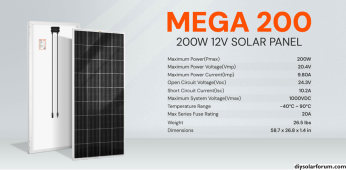glennjr1
New Member
What solar panels may be equivalent to Rich Solar 12V mega 200-Watt panels? Anyone know?

parameters. output etc.Solar panel is a mature industry now so any company with good reputation will have the similar 200w panel. What specifically does the equivalent mean? Pricing, size, efficiency or parameters?

Michael,OK, you have a very nice MPPT controller. What that means is you really don't need to focus much attention on matching the Rich Solar panels, you only need to match voltages. With your 150V limit controller, most likely you can safely wire 4-5 of those panels in series for a Vmp of 100-120V. In your cold winter climate though, you might not want to go past 4 in series, depending on what the winter lows at your location are.
Let's say for example you have three of those panels and you wire them in series to get a Vmp of ~61V. You could add a second parallel string of two larger high-voltage 60-cell residential panels putting out 8.3A at ~30.0-30.5V. So, string #1 would maximally put out ~9.8A at ~60Vmp, and the second string of two 60-cell panels in series would also be ~60V.
Why would you want to do this? Well, each one of those Rich Solar panels is selling retail for ~197$. Just a month ago, while shopping on Craigslist, I picked up some 60-cell panels for 40$ each. Bought four of them. So, I got 1000W of panels for less money then just 400W of the panels you want to match.
Shop on Craigslist in your local area, and see what kinds of cash and carry deals you can get around there. Doing a quicky search, this is what I found in Buffalo.

320W Solar Panels Canadian Solar Mono-crystalline - electronics - by owner - sale - craigslist
Brand New 320W Canadian Solar Panels 14 Available, $230 each or $3000 for all 14. These are brand new, not remanufactured or defect / blemished panels Wattage: 320W VOC: 40.1V ISC: 10.14 A Cell...buffalo.craigslist.org


